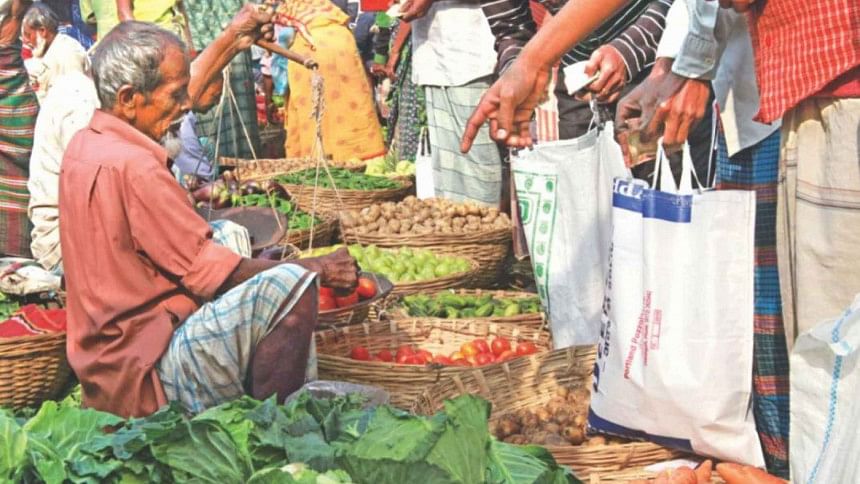How to bring price stability in the market

A common question is how and by whom are prices fixed in the market? The question arises because every now and then the price of one essential consumer item or the other goes up without our notice. The price is supposed to be established by the "invisible hand", a metaphor used by the renowned 18th century economist Adam Smith, which is the unobservable market force that determines the price of a commodity in a free market.
We need to explore the factors that act behind this invisible hand so that practical steps can be taken to avoid ups and downs occurring in the market. Also, it is important to look for both short and long-term factors behind the abnormal fluctuations in market price. We often overlook the long-term factors and take action based on immediate factors.
For example, when the price of onion went up recently, we read in the newspapers that India had to stop exporting onion to Bangladesh because of supply constraint and that is the reason for the skyrocketing of onion price here. The traders took this opportunity and immediately doubled the price. This is beyond any plausible market theory that explains such behaviour by traders. The shortage does not occur overnight but the wholesalers and retailers create an artificial crisis and raise prices to ensure huge gains for themselves. The Consumer Association of Bangladesh did not find any good reason for promptly raising the price by traders. The government acted upon the situation—it started selling onion, lentil, sugar and soybean oil through Trading Corporation of Bangladesh from early September and issued stern warning against hoarding of the commodities. But the price did not go down since the wholesale and retail traders noticed global shortages of these products and rising international prices, and continued to exploit the situation.
Despite low aggregate demand in the Bangladesh economy due to Covid-19 for the last seven months, the price level of most manufacturing products either remained the same or went down slightly, but ironically, most food items registered an increase in price. Due to drastic fall in employment and concurrent reduction of purchasing power among the poorest people, the government undertook the well-known stimulus packages to boost demand. This resulted in a stable price regime for most agricultural and farm products except fisheries and dairy products whose demand went down. The price of rice kept rising despite a bumper harvest of boro paddy in the country. The boro rice production reached an all-time high at 20.03 million tonnes in 2020 against 19.57 million tonnes in 2019. Despite achieving national self-sufficiency in food grain production through the use of high-yielding seed and appropriate technology, the food price still remains high in the country. As per the Bangladesh Bureau of Statistics, the rate of inflation in September was 5.97 percent.
The Directorate of National Consumer Rights Protection (DNCRP) analyses price rises and recommends to the Ministry of Food and Ministry of Commerce necessary measures to ease the price level. The DNCRP was founded in 2009 through the Consumer Rights Protection Act, 2009. As per DNCRP, factors that are behind the increase in rice price are increase in transport costs, huge purchase of paddy by rice millers from the farmers in the expectation of future profits, and large-scale purchase of rice by NGOs and voluntary organisations for distribution among Covid-19 affected people. The government procured only 0.23 million tonnes of paddy and rice against its target of 1.95 million tonnes this year.
Rice is a food item with a long shelf life and so can be stocked and the price can potentially be manipulated. There are about 800 semi-automatic and automatic rice mills operating in the country which can possibly act in unison and keep the mill gate price high, although no formal or informal syndicates have been unearthed by the government. But rise of vegetable prices is a different story. Severe flooding in the northern districts affected the products and is responsible for rise in vegetable prices.
Experience shows that if high price of a product sustains for a few weeks, consumers get used to paying this new price. For essential food items, poor people have no choice other than paying the high price but, of course, by cutting consumption of other items. The poorest and marginalised households are worst affected by such abrupt price rises which often sustains for months together.
To achieve a low-price regime, interaction between ultimate buyers and sellers of a product is crucial and elimination of as many layers of intermediaries as possible is desirable. We generally characterise Bangladesh as a seller's market since producers, collectors, transporters, wholesalers and retailers determine the ultimate consumer price by adding all their respective costs to come up with the final unit price.
Although the government's policy is to rely on the private sector for production, transportation and marketing of food grains, the Ministry of Food needs to act prudently whenever necessary. To keep prices stable, the government should increase procurement of rice and build up stock, to help direct producers to receive fair prices on the one hand, and on the other, undertake more open market sales, target food distribution to poor households, and provide emergency relief after natural disasters. We have to remember that many developed countries also intervene in the agricultural sector to maintain stable production and price levels. To keep food prices stable, the Ministry of Agriculture should monitor timely supply of fertiliser, seed and pesticide to farmers, and ensure low cost of irrigation through subsidised electricity supply. The government's Local Government Division should work with the Union Parishads and Paurashavas to create permanent databases of poor families so that these families can be targeted for distribution of food and cash assistance, as and when needed.
Dr Nawshad Ahmed is an economist and urban planner.

 For all latest news, follow The Daily Star's Google News channel.
For all latest news, follow The Daily Star's Google News channel. 



Comments